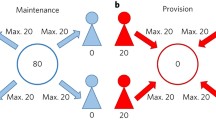Abstract
Social animals need to share space and resources, whether sexual partners, parents, or food. Sharing is indeed at the core of social life. Humans, however, of all social animals, have distinct ways of sharing. They evolved to become Homo Negotiatus; a species that is prone to bargain and to dispute the value of things until some agreement is reached.
Access this chapter
Tax calculation will be finalised at checkout
Purchases are for personal use only
Preview
Unable to display preview. Download preview PDF.
Similar content being viewed by others
References
Bowlby J (1969) Attachment. Basic Books, New York
Bruner JS (1983) Child’s talk. Norton, New York
Callaghan T, Rochat P, Lillard A, Claux ML, Odden H, Itakura S, Tapanya S, Singh S (2005) Synchrony in the onset of mental-state reasoning: evidence from five cultures. Psychol Sci 16:378–384
Decety J, Jackson PL (2006) A social-neuroscience perspective on empathy. Curr Direct Psychol Sci 15:54–58
Dewey J (1922) Human nature and conduct. An introduction to social psychology. Carlton House, New York
Eisenberg N (1989). The development of prosocial values. In: Eisenberg N, Revkowski J, Staub E (eds) Social and moral values: individual and societal perspectives. Lawrence Erlbaum Associates, Inc, Hillsdale, NJ, pp 87–103
Hobson P (2003) The cradle of thought. Oxford University Press, Oxford
Kagan J (1984) The nature of the child. Basic Books, New York
Lewis M (1992) Shame: the exposed self. Free Press, New York
Lewis M, Brooks-Gunn J (1979) Social cognition and the acquisition self. Plenum Press, New York
Malinowski B (1932) Argonauts of the Western Pacific: an account of native enterprise and adventure in the archipelagoes of Melanesian New Guinea. Routledge & Sons, London
Mauss M (1952/1967) The Gift: forms and functions of exchange in archaic societies. Norton, New York
Morton J, Johnson MH (1991) CONSPEC and CONLERN: a two-process theory of infant face recognition. Psychol Rev 98:164–181
Reed ES (1982) An outline of a theory of action systems. J Motor Behav 14:98–134
Rochat P (2001) The infant’s world. The Developing Child Series. Harvard University Press, Cambridge, US
Rochat P (2003) Five levels of self-awareness as they unfold early in life. Conscious Cogn 12:717–731
Rochat P (2005) Humans evolved to become Homo Negotiatus…the rest followed. Behav Brain Sci 28:714–715
Rochat P (2006) What does it mean to be human? J Anthropol Psychol 17:100–107
Rochat P (2007) Intentional action arises from early reciprocal exchanges. Acta Psychol 124:8–25
Rochat P (2008, in press) Others in Mind: social origins of self-consciousness. Cambridge University Press, NY
Rochat P, Callaghan T (2005). What drives symbolic development? In: Namy L (ed) Symbolic use and understanding. Lawrence Erlbaum Associates Publishers, Mahwah, NJ
Rochat P, Senders SJ (1991) Active touch in infancy: action systems in development. In: Weiss MJ, Zelazo PR (eds) Infant attention: biological contraints and the influence of experience. Ablex Publishers, Norwood, NJ, pp 412–442
Rochat P, Striano T (1999a). Social cognitive development in the first year. In: P Rochat (ed) Early social cognition. Lawrence Erlbaum Associates, Mahaw, pp 3–34
Rochat P, Striano T (1999b) Emerging self-exploration by 2 month-old infants. Dev Sci 2:206–218
Spitz RA (1965) The first year of life: a psychoanalytic study of normal and deviant development of object relations. Basic Books, New York
Stern D (1985) The interpersonal world of the infant. Basic Books, New York
Striano T, Rochat P (1999) Developmental link between dyadic and triadic social competence in infancy. Br J Dev Psychol 17:551–562
Striano T, Rochat P (2000) Emergence of selective social referencing in infancy. Infancy 2:253–264
Tomasello M (1995). Joint attention as social cognition. In: Moore C, Dunham P (eds) Join attention: its origins and role in development. Erlbaum, Hillsdale, NJ, pp 103–130
Tomasello M (1998) One child early talk about possession. In: Newman J (ed) The linguistic of giving. John Benjamins, Philadelphia, pp 349–373
Tomasello M (1999) Cultural origins of human cognition. Harvard University Press, Cambridge
Tomasello M, Call J (1997) Primate cognition. Oxford University Press, New York
Tomasello M, Farrar MJ (1986) Joint attention and early language. Child Dev 57: 1454–1463
Trevarthen C (1979). Communication and cooperation in early infancy: a description of primary intersubjectivity. In: Bullowa MM (ed) Before speech: the beginning of interpersonal communication. Cambridge University Press, New York, pp 321–347
De Waal FBM (1989) Peacemaking among primates. Harvard University Press, Cambridge, MA
Wellman HM (2002). Understanding the psychological world: developing a theory of mind. In: Goswani U (ed) Blackwell handbook of child cognitive development. Black-well Publishing, Oxford, UK, pp 167–187
Wimmer H, Perner J (1983) Beliefs about beliefs: representation and constraining function of wrong beliefs in young children’s understanding of deception. Cognition 13:103–128
Winnicott DW (1982) Playing and reality. Tavistock Publications, London/New York
Zahn-Waxler C, Radke-Yarrow M, Wagner E, Chapman M (1992) Development of concern for others Dev Psychol 28:126–136
Author information
Authors and Affiliations
Editor information
Editors and Affiliations
Rights and permissions
Copyright information
© 2008 Springer
About this chapter
Cite this chapter
Rochat, P., Ferreira, C.P. (2008). Homo Negotiatus: Ontogeny of the Unique Ways Humans Own, Share and Reciprocate. In: Itakura, S., Fujita, K. (eds) Origins of the Social Mind. Springer, Tokyo. https://doi.org/10.1007/978-4-431-75179-3_7
Download citation
DOI: https://doi.org/10.1007/978-4-431-75179-3_7
Publisher Name: Springer, Tokyo
Print ISBN: 978-4-431-75178-6
Online ISBN: 978-4-431-75179-3
eBook Packages: Behavioral ScienceBehavioral Science and Psychology (R0)




